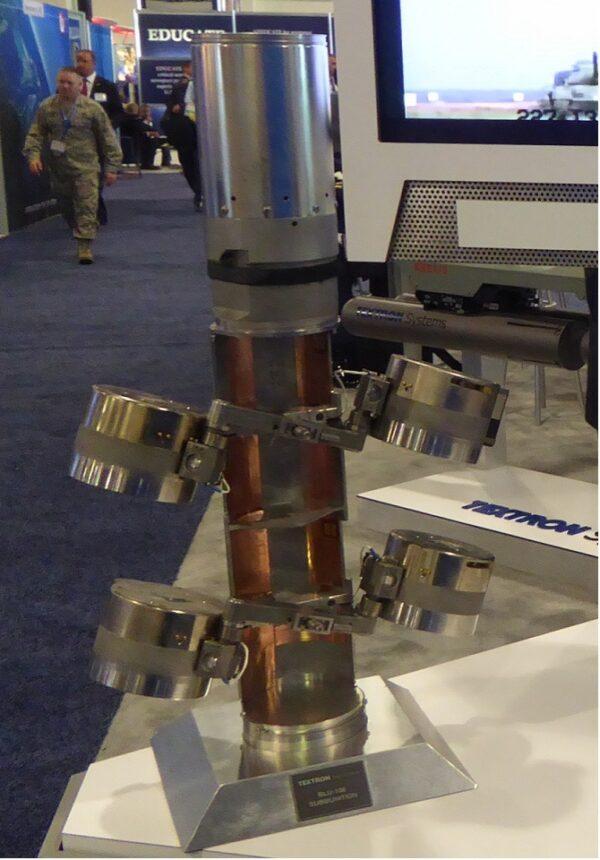Without recourse to deploying troops and nuclear weapons, America has the means to help Ukraine defeat an invasion by Russian dictator Vladimir Putin, and to prevent his likely subsequent military attempts to reassemble the old Warsaw Pact and destroy the North Atlantic Treaty Organization (NATO) alliance.
By giving Ukraine several hundred BLU-105 bombs, each armed with 40 individually targetable sensor fuzed weapons (SFWs), it is possible to give Ukraine the means to destroy up to thousands of Russian armored systems and essential logistic support vehicles.
Developed during the 1980s to counter vast Soviet armored formations that threatened Europe, but not purchased until the early 1990s after the collapse of the Communist Party of the Soviet Union, SFWs are about the size of a Big Mac and combine an infrared/laser sensor with an explosively shaped molten-metal projectile.
With a spin-stabilized body, the sensor searches the battlefield below and can find a hot target like a tank engine, and at the correct altitude, fires the explosively formed molten metal slug at a supersonic speed so that it will penetrate most armor and metal. It could hit a tank’s ammunition and cause an explosion, or slice through the engine and halt the tank or truck.
During a late August 2003 air support sortie during Operation Iraqi Freedom, one U.S. Air Force B-52 bomber dropped two BLU-105 SFW bombs that “decimated” the first third on an Iraqi tank column, forcing those at the end to surrender to U.S. Marines.
The ideal time for employment would be at the beginning of an offensive, when Russian armored vehicles and trucks will be generating great heat standing out in the freezing winter, presenting ideal targets for SFWs. There is little defense against the supersonic molten metal slug once it is fired.
One issue is that Ukraine would have to use most of its 125 or so combat aircraft to deliver the BLU-105s against Russia’s sophisticated multi-layer missile and anti-aircraft gun air defenses, perhaps the most formidable in the world.

However, when used in coordination with unmanned decoy aircraft or hundreds of loitering munitions, combined with the chaos of the initial stages of the Russian offensive, it is possible that some aircraft will deliver their SFWs and blunt many axes of the Russian attack.
A better alternative would be to arm short-range ballistic missiles or long-range artillery rockets with SFWs, as these are far less vulnerable to Russian short-range air defenses.
The United States would have to begin a crash program to develop missile warheads armed with SFWs, as it has produced only about 3,000 BLU-109 bombs, and no SFW armed missiles. This happened because of early political opposition to SFWs and as they became targets of a global campaign to eliminate cluster munitions.
In an August 1991 report, the usually anti-weapon General Accounting Office (GAO) recommended against the production of SFWs, commenting rather dismissively:
“The Air Force developed the Sensor Fuzed Weapon primarily to counteract the Warsaw Pact’s numerical advantage in tanks in Central Europe. However, this primary threat has changed considerably over the last year with the dissolution of the Warsaw Pact and, according to intelligence agencies, the defensive posture adopted by the Soviet Union.”
Luckily, the U.S. Air Force did not heed the GAO and purchased SFWs. The GAO did not predict that in 2022 the Russian Army would be close to assembling up to 100 of its battalion tactical groups (GTGs) for its assault on Ukraine. Such a force could potentially include 1,000 tanks, 1,100 armored fighting vehicles, and 1,800 tube and rocket artillery pieces.
Should Ukrainian combat aircraft break through Russian air defenses and deliver the bulk of 400 BLU-105s within hours of the Russian force starting their engines, enough tanks, armored vehicles, trucks, and artillery could be destroyed to significantly increase the effectiveness of Ukraine’s tanks and anti-tank missiles against the remaining Russian invaders.
Should Ukraine be able to destroy a large proportion of Russia’s assembled tanks, fighting vehicles and artillery, that would then greatly deflate Russia’s ability to threaten the Baltic States and Poland. A large enough surprise “defeat” by Ukraine may even destabilize Putin’s regime, prompting a possible coup.
Should Russia be so destabilized by a surprise military defeat, that would shake China’s confidence in its deepening strategic alliance with Russia, which it hopes will vault it toward hegemony on Earth and on the moon.
Unfortunately, while the U.S. Air Force may retain its inventory of BLU-105 SFW bombs, reports indicate that SFW manufacturer Textron halted their production in 2016 after the Obama administration halted a shipment of 400 to Saudi Arabia.
Due to a 15-year campaign by leftist groups, the SFW had been lumped in with cluster munitions, even though the SFW is largely harmless if its hits the ground unfired, whereas there are plenty of other anti-personnel cluster munitions that could cause such unintended harm.
If the Biden administration truly wanted to give Putin a destabilizing bloody nose without having to deploy thousands of U.S. troops to Europe, while also decreasing Putin’s threat to the Baltic States, Poland, and the survival of the NATO alliance, it would immediately transfer hundreds of BLU-105 sensor fuzed weapons to Ukraine.






Friends Read Free